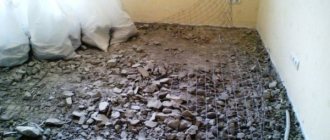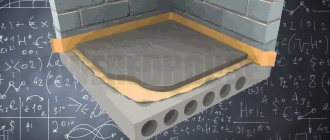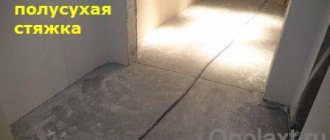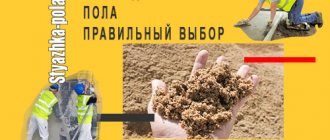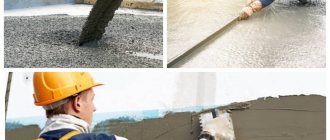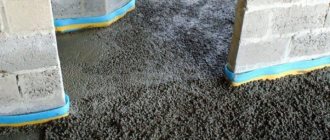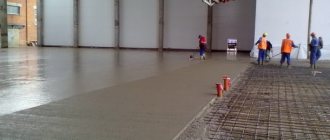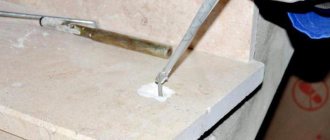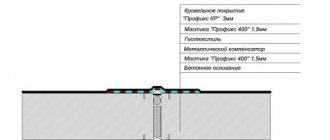Why is fiber needed?
The main requirements for the base on which the finished floor covering is laid are strength, rigidity and stability. For a screed to have such characteristics, it is not enough to follow the technology and proportions of the main components when making the mortar; it must be reinforced. This problem can be solved by using fiber screed, which is added to the concrete mixture when mixing it.
Traditional reinforcement with steel mesh does not solve the problem of cracking of a thick layer of concrete during drying and shrinkage, accompanied by evaporation of water. And if the thickness of the screed is small, the mesh is not used at all. Small cracks expand and deepen over time, the subfloor loses strength and begins to crumble.
Destruction of unreinforced screed Source jooinn.com
Fiber reinforces the screed throughout its entire thickness. Randomly located fibers allow:
- reduce the amount of water for mixing and, accordingly, microvoids formed during its evaporation;
- accelerate the hardening of the solution;
- reduce the risk of cracks;
- prevent delamination of drying concrete;
- increase the strength of the finished screed, its resistance to abrasion, impact, bending and compressive loads;
- increase the frost resistance of the coating.
One of the advantages of fiberglass for floor screed is that the consumption per m2 is quite small, and in terms of money it is much cheaper than reinforcing mesh. In this case, the mesh must be laid on spacers so that it is embedded in the thickness of the concrete, and its installation takes a lot of time. And fiber is simply added to the batch along with other components.
See also: Catalog of companies that specialize in redevelopment of country houses of any complexity
Characteristics of fiber reinforced concrete
Dispersed reinforcement of concrete with fiber gives the material the following properties:
- high compressive, tensile and bending strength;
- resistance to the formation of shrinkage cracks and microcracks (fiber reduces the internal stress of concrete);
- high impact resistance, abrasion resistance;
- frost resistance, resistance to freezing/thawing processes;
- waterproof;
- heat and sound insulation;
- plasticity - fiberglass fiber in concrete allows it to be used for finishing corners of buildings and producing decorative elements of facades.
Also, reinforcing concrete with fiber helps to increase the fire resistance of the material. Such concrete can be used in the construction and finishing of premises with special safety requirements.
Fiber completely fills the concrete structure, creating reliable protection against the penetration of moisture, chemicals: acids, alkalis, etc.
Types of reinforcing fiber
There are different types of fiber, differing not only in material, but also in the size of the fibers, which affect the scope of application. Fiber for floor screed must have the following fiber parameters:
- length from 4 to 25 mm:
- thickness from 10 to 200 microns.
Polypropylene fiber fiber Source ekonom11.ru
Such a wide range of parameters is explained by the fact that reinforcing fibers are made from different materials - steel, molten glass, rocks, polymers. Regardless of their origin, they are all designed to strengthen concrete pavements, but have some differences in properties and characteristics.
Steel fiber
Representing pieces of thin wire or small cuts from a sheet, steel fiber is distinguished by its largest dimensions and heavy weight. Due to its high strength and fire resistance, it is used for thick screeds designed for high loads and difficult operating conditions. For example, in factory floors, warehouses, and sales areas.
Steel fiber fiber Source tck-market.ru
The disadvantage of the material is its instability to corrosion. Gradually, steel fibers, even those with a special coating, rust, become thinner, and their strength decreases.
Fiberglass
Fiberglass fiber for screeds is not very strong, so it is used mainly for non-load-bearing thin screeds 3-4 cm thick, as well as for reinforcing plasters. But it is very plastic and resistant to the alkaline environment of concrete mortar.
Technical characteristics of glass fiber are indicated on the label Source ecohub.ru
Production of fiber fiber from polypropylene
These fibers are made from granules of synthetic material - polypropylene, by extrusion and drawing, as a result of heating to a certain temperature. After which a special layer is applied to the surface of the fibers, which stimulates dispersion and ensures adhesion of the microfiber to cementitious materials - solutions and mixtures.
What is polypropylene fiber used for? For uniform micro-reinforcement of concrete and concrete mortars throughout the entire volume of the product. Experience with the use of this reinforcing material has proven that polypropylene microfibers make the amount of microcrack formation much smaller and prevent them from developing into cracks, and also promote compaction at the microstructural level. All this affects the aesthetics of finished concrete structures and products and their durability.
Consumption
Adding fiber fiber to the screed solution does not in any way affect the proportions of dry components, but it allows you to reduce the amount of water. The application rate is indicated on the packaging, but sometimes it is purchased by weight, without instructions for use, so you need to know the fiber consumption per 1 m³ of screed for each type.
- Polypropylene – 0.9-1.5 kg.
- Fiberglass and basalt - 0.6-1 kg.
- Steel 30-50 kg.
- Carbon – 0.9-1 kg.
It is important! Excessive amounts of reinforcing fiber can impair the strength of concrete, so the specified proportions must be strictly observed.
Methods of using reinforcing fiber
The fiber is very light in weight, so it is economical and significantly reduces cement consumption. Recommended dosage – 900 g. per 1 cubic meter of concrete solution. You can increase the dose (up to 1.5 kg of fiber per 1 m³ of mixture). There are three ways to use fiber, and all of them are correct:
- Add to the dry ingredients of the mixture, and then add water.
- Add along with water.
- Add to the solution gradually, in small portions, while mixing it.
The main thing is to increase the mixing time of the concrete solution compared to usual. It is very important that the fiber is distributed as evenly as possible throughout the concrete mixture. Overall, polypropylene fiber is a reasonable and progressive alternative to conventional concrete reinforcement. It provides good savings in money, time and labor costs, and improves the performance characteristics of concrete. Therefore, its use is fully justified in all the areas described above.
Video description
This video talks about all types of fiber for screed:
Approximate prices for fiber per 1 kg:
- Polypropylene – 200-300 rubles.
- Basalt – 160-240 rub.
- Fiberglass - 100-180 rubles.
- Steel – 50-65 rub.
- Carbon – 2500-4000 rub.
But the price of the material in itself does not mean anything; it must be considered in conjunction with the consumption rate. Let's compare the cheapest steel fiber with carbon fiber, which has the highest cost.
Steel fiber for concrete – consumption per m³ averages 40 kg. With an average cost of 58 rubles we get:
40 x 58 = 2320 rub.
The same volume of solution requires only 1 kg of carbon fiber, costing about 3,000 rubles.
The final difference is not as noticeable as the price per kilogram of product.
Based on the totality of all parameters, fiber fibers made from basalt and polypropylene can be considered leaders. They provide good strength, are economical in consumption and are affordable.
Mixing the solution with fiber fiber
The use of fiber does not make any noticeable changes in the process of mixing the solution. The main task is to evenly distribute the fibers in the mass of sand concrete for its volumetric reinforcement and prevent the formation of lumps. To do this, first mix all the dry ingredients and then dilute them with water.
Type of finished solution Source wexy.ru
The fiber consumption per 1 m² of screed or per batch is calculated based on the proportions. If 600 grams of fiber are required for 1 cubic meter of concrete, then 5 times less is poured into a concrete mixer for 0.2 cubic meters - 150 grams.
For reference! For the convenience of private developers, many manufacturers produce fiber in packages of the volume required to mix a cubic meter of solution.
Label from the packaging of basalt fiber Source ognebio61.ru
The finished solution is immediately poured onto the base and leveled using the rule. This technology compares favorably with reinforcing the screed with a mesh, which must be laid out and fixed at a certain distance from the floor. Fiber, in contrast, is evenly distributed throughout the entire thickness of the screed and reinforces it in all planes from top to bottom.
Possible conditions for use
The purpose of polypropylene fiber has a fairly wide area. It is more often recommended to use it for all types of concrete and for mortars, regardless of their purpose.
Advantages of polypropylene fiber:
- Economic feasibility, the cost of using polypropylene fiber is much lower than that of metal structures for reinforcement, while its use requires much less labor and time for the manufacture of concrete products, in contrast to traditional reinforcement with metal mesh. In addition, evenly distributed fibers make it possible to provide finished products with higher quality properties.
- Polypropylene fiber is very thin and flexible fibers; they are evenly distributed throughout the entire volume and are completely invisible when dry.
- The use of this type of fiber increases the bending strength and eliminates delamination.
- They are used for solutions at low temperatures, since polypropylene fiber has a high frost resistance and is also resistant to thawing.
Areas of use of microfiber
- installation and production of industrial floors;
- construction of hydraulic buildings and structures;
- production of monolithic and prefabricated concrete structures;
- construction of concrete roads;
- production of various external platforms;
- production of concrete slabs;
- pouring foundations;
- construction of bridges and piles;
- production of building mixtures and solutions, including plaster;
- production of all types of cellular concrete;
- production of pressed and cast products;
- production of decorative concrete;
- production of materials intended for the repair of concrete products;
- production of shotcrete;
- production of dry and semi-dry mixtures for construction;
- for the construction of petrochemical facilities;
- for construction in places with periodic seismic vibrations.
Briefly about the main thing
When screeding the floor in your home, you can speed up both the pouring process and the drying time by adding fiberglass to the solution. It will allow you to do without reinforcing mesh for a thick screed and make a thin layer of sand concrete strong enough. The effectiveness of using this reinforcing material depends on compliance with the proportions and high-quality mixing of the solution for uniform distribution of fibers. The consumption of fiber per unit volume of the finished solution depends on its type.
Ratings 0
Areas of use
One of the main properties of the polymer is its versatility. Despite the fact that fiber is mainly used as a reinforcing additive in concrete, it can be used in any building mixture containing gypsum or cement. Recently, fiber began to be used to create foam concrete, which improved its strength and resistance to external influences several times.
Polypropylene fiber has found wide application as the main types of structures:
- in foundations;
- in piles;
- in foam blocks;
- when creating a floor screed;
- in the formation of the blind area.
The wide range of applications of the material allows it to easily conquer the construction industry.


